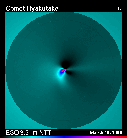Comet Hyakutake's Dust Tail (March 20 - April 5, 1996)
Read More:

Dust Jets (ESO NTT Image)
Prepared by Hermann Boehnhardt (Institute for Astronomy and Astrophysics, University of Munich); 26 February 1996
ESO has received quite a few requests for information about the actual appearance of Comet Hyakutake when it approaches the Earth in late March 1996. An important aspect is the dust tail: in which direction will it point and how broad will it be ? Will perhaps the Earth pass through it ?
I here show some plots which illustrate the general view and comment below on the expected changes, etc.
Dust tail calculations
For these calculations, I have used a 'Finson-Probstein' programme to generate plots that show the geometry of the dust tail at ten dates in the interval from March 20 to April 5, 1996 . The plots display the predicted shape of the tail as seen in the orbital plane , and as seen from the Earth, i.e. in the sky tangential plane (here: `the photographic plane'), As a basis served the orbital elements which have been published in MPEC 1996-C06.
These calculations produce a grid of synchrones and syndynes . The synchrones correspond to the locations of dust particles which have been emitted at the same time; the syndynes to dust particles which have been subjected to the same pressure by the sunlight (normally, particles of the same size). In the present case, the dust particles are assumed to have initial zero velocity, relative to the comet coma. The scale of the plot is given in AU, together with the projected direction of the cometary motion and towards the Sun. The comet's distance from the Sun and the Earth is indicated. North is up and East is to the left in the sky plots. The direction to the Earth, from the comet's nucleus, is given as a unit vector; when the third coordinate of this vector (z) is 0, the Earth passes through the orbital plane of the comet. The position of the nucleus is indicated with a small star.
For the calculations, I used dust emission times covering up to 60 days before the observing dates as given in the header of the plots and solar radiation pressures values beta between 0.1 and 1.0. According to my experience this parameter choice should reasonably well correspond to the grains which typically produce the visual tail pattern of comets. However, these plots show the dust particle positions only, and are thus only indicative of the tail appearance. For instance, possible outbursts will produce enhanced synchrone patterns.
The plots
The entire series of twenty plots is available as a rather large Postscript file [1.35M]. In order to facilitate the access, the plots are also available as individual GIF files [each about 9k], one for each date and each viewing angle (in orbital plane and in the sky plane).
Plots in orbital plane [GIF]
March 20 - March 22 - March 24 - March 25 - March 26 - March 27 - March 28 - March 29 - March 30 - March 31 - April 5 .
Plots in tangential sky plane (as seen from the Earth) [GIF]
March 20 - March 22 - March 24 - March 25 - March 26 - March 27 - March 28 - March 29 - March 30 - March 31 - April 5 .
Conclusions
In summary, from now on until about March 20, we can expect a narrow dust tail pointing in the general antisolar direction (p.a. = 250 - 270 deg). Thereafter, the tail orientation changes rapidly from day to day, in particular from March 24 to 29.
On March 28-29, the Earth will pass through the orbital plane of the comet, which will result in a nearly edge-on view of the dust tail, visible during a few days preceding and following this event. The tail axis will then be inclined by more than 65 deg to the Earth direction, i.e. foreshortening effects on the tail will be small. The dust tail orientation follows very much the p.a. angle as given in the ephemerides . No anti-tail is expected to occur during the orbital plane passage of the comet.
There is no chance that the Earth will pass through the dust tail of comet Hyakutake during the days of closest approach and during the period when it crosses the comet's orbital plane.
While approaching the Sun in April, the dust tail is oriented towards p.a. = 45 - 40 deg and will eventually become somewhat broader than before.